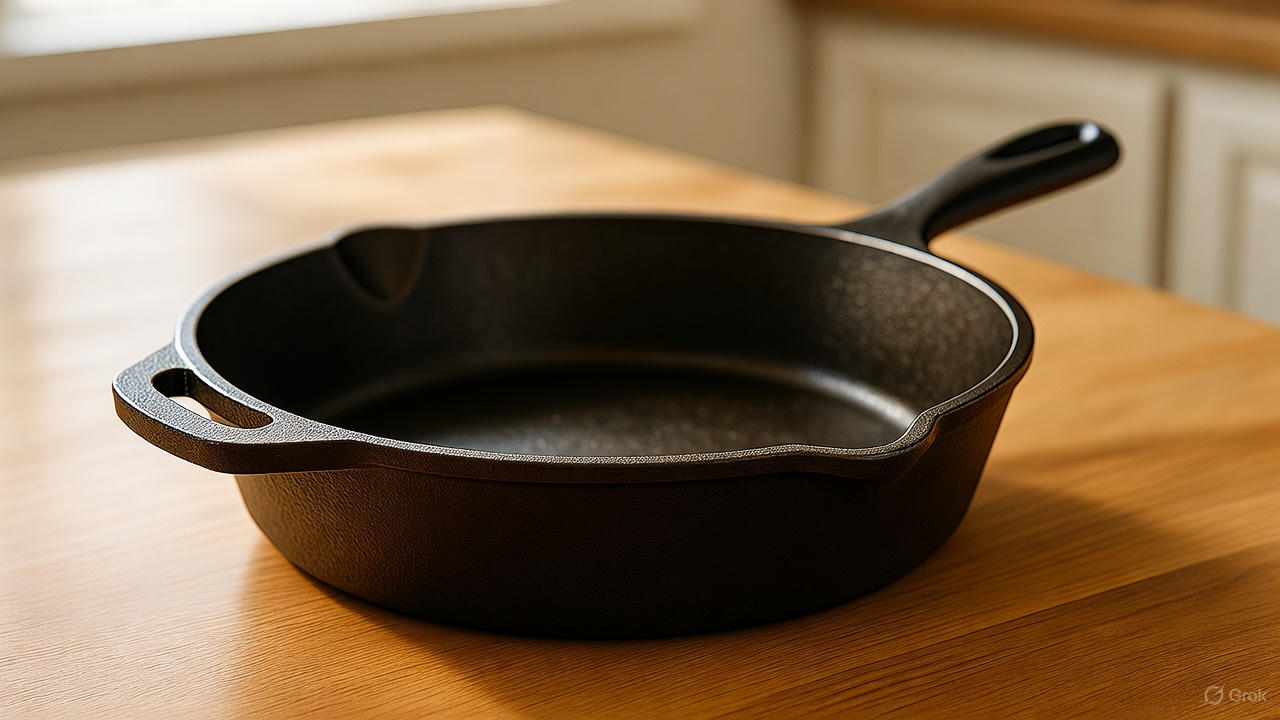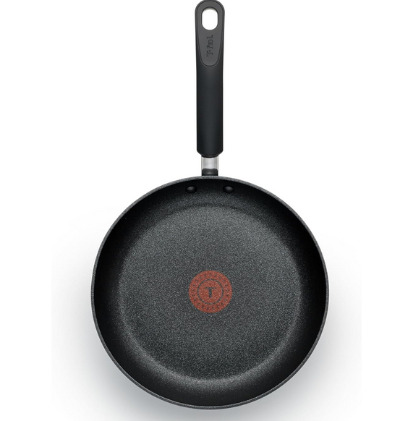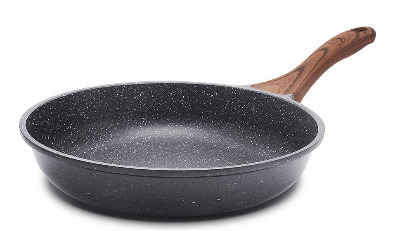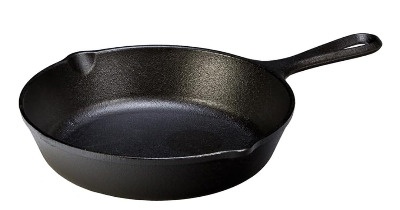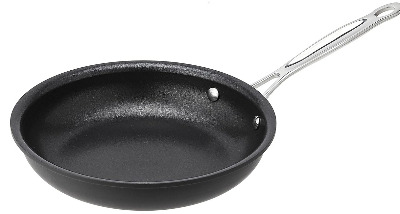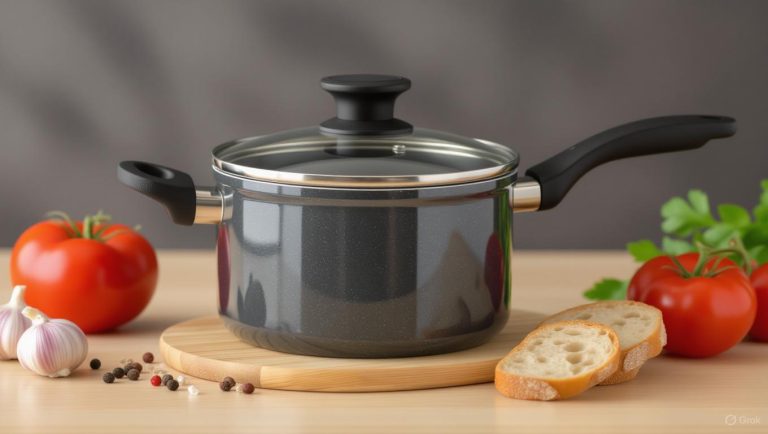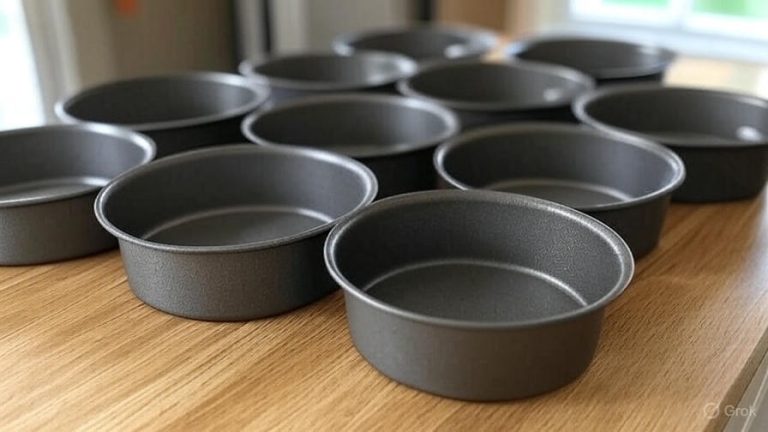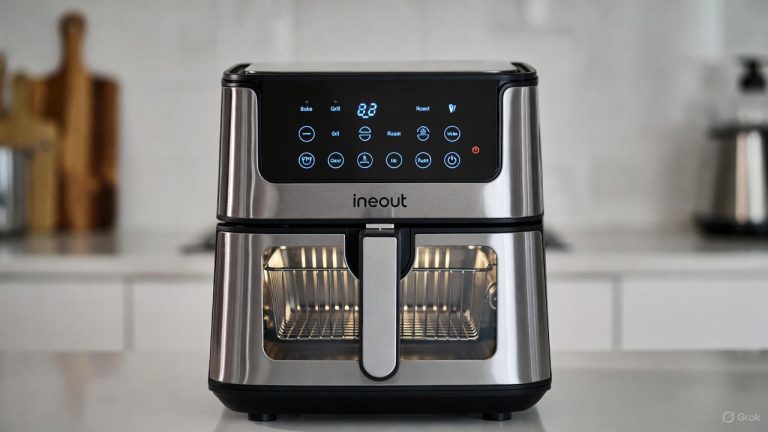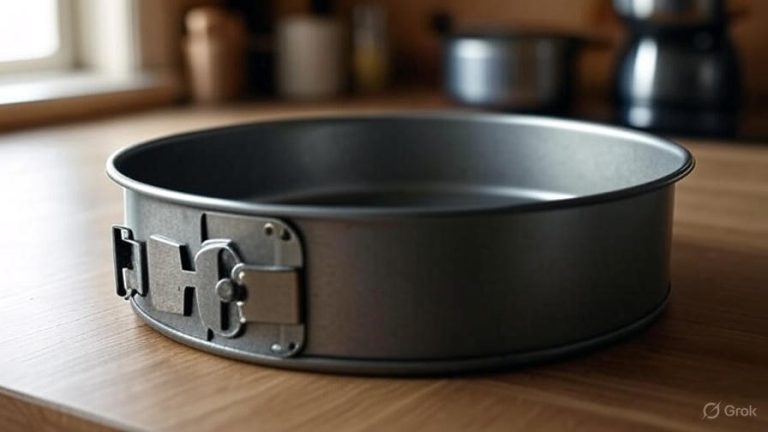5 Best 8 Inch Skillets In 2025
Finding the perfect 8-inch skillet can transform your cooking experience. These compact frying pans offer exceptional versatility for small batch cooking, single servings, and side dishes. After extensive testing and analysis, we’ve compiled this comprehensive review of the top five 8-inch skillets that deliver outstanding performance across various cooking styles and budgets.
Why an 8-Inch Skillet Deserves a Place in Your Kitchen
The 8-inch skillet represents the sweet spot between functionality and convenience. This size works perfectly for cooking eggs, searing single portions of protein, sautéing vegetables, and preparing quick sauces. Unlike larger pans that can feel unwieldy for small tasks, an 8-inch skillet provides precise heat control and easy maneuverability.
Home cooks appreciate how these smaller pans heat up quickly and distribute temperature evenly across their compact surface. The size also makes storage simple, fitting easily into most cabinets without taking up excessive space. For apartment dwellers or those with limited kitchen storage, an 8-inch pan serves as an essential workhorse.
Professional chefs often reach for 8-inch skillets when preparing garnishes, finishing touches, or individual portions. The controlled cooking surface allows for delicate techniques like making perfect omelets or achieving ideal browning on small cuts of meat.
Our Top 5 Best 8-Inch Skillets Reviewed
1. T-fal C4610263 Titanium Advanced Nonstick – Best Overall Performance
The T-fal C4610263 Titanium Advanced stands out as our top pick for its innovative Thermo-Spot heat indicator technology. This unique feature eliminates guesswork by showing you exactly when the pan reaches optimal cooking temperature. The indicator spot changes from red to solid red when the surface is properly heated, preventing common cooking mistakes.
Key Features:
- Titanium-reinforced nonstick coating resists scratching and wear
- Thermo-Spot heat indicator for perfect timing
- Even heat distribution prevents hot spots
- Dishwasher safe construction
- Comfortable ergonomic handle stays cool during cooking
The nonstick surface performs exceptionally well with delicate foods like fish fillets and crepes. Eggs slide effortlessly across the surface without sticking, even when using minimal oil. The titanium reinforcement extends the coating’s lifespan significantly compared to standard nonstick pans.
Heat distribution remains consistent across the entire cooking surface, thanks to T-fal’s advanced aluminum base construction. This even heating prevents the frustrating hot spots that can burn food in patches while leaving other areas undercooked.
The handle design deserves special mention for its comfortable grip and heat-resistant properties. Even during extended cooking sessions, the handle remains cool enough to grip safely without potholders.
Pros:
- Innovative heat indicator technology
- Durable titanium-reinforced coating
- Excellent heat distribution
- Easy cleanup
- Great value for the features offered
Cons:
- Not suitable for metal utensils
- Cannot withstand extremely high heat
- Nonstick coating will eventually wear with heavy use
2. SENSARTE Nonstick Frying Pan – Best for Health-Conscious Cooks
The SENSARTE 8-inch skillet earns recognition for its Swiss granite coating that delivers both performance and peace of mind for health-conscious cooks. This PFOA-free surface provides excellent nonstick properties while avoiding potentially harmful chemicals found in traditional coatings.
Key Features:
- Swiss granite coating technology
- PFOA-free and safe for family use
- Stone-derived nonstick surface
- Suitable for all stovetop types except induction
- Attractive granite appearance
The granite coating creates a naturally nonstick surface that releases food easily without requiring excessive oil or butter. This feature makes it ideal for preparing healthier meals with reduced fat content. The coating also demonstrates impressive durability, maintaining its nonstick properties even after months of regular use.
Temperature tolerance exceeds many competitors, allowing for higher heat cooking when needed for searing or browning. The stone-derived surface can handle temperature fluctuations better than traditional nonstick coatings, making it more versatile for various cooking techniques.
The pan’s construction provides steady heat distribution, though not quite as even as our top pick. However, the difference remains minimal for most home cooking applications. The attractive granite appearance adds visual appeal to your cookware collection.
Pros:
- Chemical-free granite coating
- Excellent nonstick performance
- Higher heat tolerance than traditional nonstick
- Attractive appearance
- Good durability
Cons:
- Not induction compatible
- Slightly heavier than aluminum alternatives
- May require longer preheating time
3. OXO Enhanced 8″ Frying Pan – Best Premium Option
The OXO Enhanced represents premium cookware engineering with its PFAS-free ceramic nonstick coating and hard anodized construction. This skillet targets serious home cooks who demand professional-grade performance and are willing to invest in superior materials.
Key Features:
- PFAS-free ceramic nonstick coating
- Hard anodized aluminum construction
- Scratch-resistant surface
- Stainless steel handle with comfortable grip
- Oven safe up to 430°F
- Dishwasher safe
The ceramic nonstick coating provides exceptional release properties while maintaining safety standards that exceed industry requirements. Unlike traditional nonstick surfaces, this ceramic coating can withstand higher temperatures without degrading or releasing harmful compounds.
Hard anodized construction creates a surface that’s twice as hard as stainless steel, providing exceptional durability and resistance to warping. This process also creates superior heat conduction properties, ensuring consistent temperature distribution across the cooking surface.
The stainless steel handle features OXO’s signature Good Grips design, providing secure handling even when wearing gloves or dealing with wet hands. The handle stays comfortable during extended cooking sessions and transitions safely to oven use.
Performance testing reveals excellent browning capabilities and superior heat retention compared to lighter pans. The substantial construction provides restaurant-quality results for home cooks who appreciate professional-grade equipment.
Pros:
- Premium materials and construction
- Excellent heat retention and distribution
- Oven safe to high temperatures
- Scratch-resistant surface
- Professional-grade performance
Cons:
- Higher price point
- Heavier than aluminum alternatives
- Requires proper care to maintain ceramic coating
4. Lodge 8 Inch Cast Iron Pre-Seasoned Skillet – Best Traditional Option
The Lodge cast iron skillet represents timeless cooking tradition combined with modern convenience. This pre-seasoned pan arrives ready to use and develops better nonstick properties over time with proper care and seasoning maintenance.
Key Features:
- Pre-seasoned with vegetable oil
- Signature teardrop handle design
- Versatile cooking surface for stovetop, oven, grill, and campfire
- Exceptional heat retention
- Improves with age and use
- Made in USA
Cast iron provides unmatched heat retention and even temperature distribution once properly heated. This thermal mass allows for excellent searing capabilities and maintains consistent temperatures during cooking, making it perfect for techniques requiring steady heat.
The pre-seasoning process saves time and effort, allowing immediate use without the traditional seasoning ritual required for raw cast iron. However, the seasoning continues to improve with regular use and proper maintenance, eventually developing a naturally nonstick surface.
Versatility stands as cast iron’s greatest strength. This pan transitions seamlessly from stovetop to oven, grill, or even campfire cooking. The durability ensures it can last generations with proper care, making it an excellent long-term investment.
The signature teardrop handle provides a secure grip while distributing weight evenly. Though the pan requires more care than modern nonstick options, many cooks find the ritual of cast iron maintenance rewarding and the cooking results superior.
Pros:
- Exceptional heat retention
- Improves with age and use
- Incredibly versatile and durable
- Made in USA with quality materials
- Can last generations
Cons:
- Requires regular seasoning maintenance
- Heavier than other options
- Not naturally nonstick initially
- Can rust if not properly maintained
5. Cuisinart 622-20 Chef’s Classic – Best Budget Choice
The Cuisinart Chef’s Classic delivers solid performance at an accessible price point. This hard-anodized skillet provides many features found in premium pans while maintaining affordability for budget-conscious home cooks.
Key Features:
- Hard-anodized aluminum construction
- Quantanium nonstick interior
- Solid stainless steel riveted handle
- Even heat distribution
- Dishwasher safe
- Oven safe to 500°F
The hard-anodized exterior creates a durable, non-reactive cooking surface that resists corrosion and provides excellent heat conduction. This process makes the aluminum twice as hard as stainless steel while maintaining lightweight handling characteristics.
Quantanium nonstick coating provides reliable food release properties for everyday cooking tasks. While not as advanced as premium ceramic or titanium-reinforced coatings, it performs adequately for most home cooking applications and offers good durability for the price point.
Heat distribution proves consistent across the cooking surface, preventing hot spots that can burn delicate foods. The aluminum construction heats quickly and responds well to temperature adjustments, providing good cooking control.
The stainless steel handle stays securely attached through solid riveting and maintains comfortable temperatures during normal cooking. Oven safety up to 500°F expands cooking possibilities and allows for techniques requiring high heat.
Pros:
- Excellent value for the price
- Solid construction and materials
- Good heat distribution
- Oven safe to high temperatures
- Reliable everyday performance
Cons:
- Nonstick coating less advanced than premium options
- May show wear sooner with heavy use
- Handle can get warm during extended cooking
Buying Guide: How to Choose the Perfect 8-Inch Skillet
Material Considerations
Nonstick Aluminum: These pans offer easy cleanup and require minimal oil for cooking. Modern nonstick coatings like ceramic and titanium-reinforced options provide better durability than traditional coatings. However, they require careful handling to prevent scratching and have limited lifespan compared to other materials.
Hard-Anodized Aluminum: This material provides excellent heat conduction while offering superior durability compared to regular aluminum. The anodizing process creates a non-reactive surface that won’t interact with acidic foods. These pans often feature nonstick coatings for easy food release.
Cast Iron: Traditional cast iron develops natural nonstick properties over time and provides unmatched heat retention. These pans can transition from stovetop to oven seamlessly and actually improve with proper use and care. However, they require more maintenance and are significantly heavier than aluminum alternatives.
Coating Types
Traditional Nonstick: PTFE-based coatings provide excellent food release but require careful temperature control and gentle handling. These coatings work well for everyday cooking but have shorter lifespans than other options.
Ceramic Nonstick: These coatings offer chemical-free nonstick properties and can withstand higher temperatures than traditional options. They provide good durability but may lose nonstick properties gradually over time.
Titanium-Reinforced: These advanced coatings combine traditional nonstick properties with enhanced durability. The titanium reinforcement helps resist scratching and extends the coating’s functional life.
Handle Design and Safety
Look for handles that stay cool during cooking and provide secure grip even when wet. Stainless steel handles offer durability and oven safety, while plastic or silicone handles may provide better heat insulation but limit oven use.
Riveted handles provide superior attachment strength compared to welded options. The handle should feel balanced in your hand and not make the pan feel front-heavy or awkward during use.
Heat Distribution and Performance
Even heat distribution prevents hot spots that can burn food while leaving other areas undercooked. Look for pans with thick, heavy bottoms that distribute heat evenly across the entire cooking surface.
Responsive temperature control allows precise cooking adjustments. Aluminum excels in this area, heating quickly and cooling down rapidly when heat is reduced. Cast iron provides excellent heat retention but changes temperature more slowly.
Care and Maintenance Tips
Nonstick Pan Care
Always allow nonstick pans to cool completely before washing to prevent warping. Use soft sponges and avoid abrasive cleaners that can damage the coating. Hand washing extends the life of nonstick surfaces, even if the manufacturer claims dishwasher safety.
Store nonstick pans carefully to prevent scratching. Use pan protectors or nest them with soft cloth between surfaces. Avoid stacking without protection, as this can damage the nonstick coating.
Use wooden, plastic, or silicone utensils to prevent scratching. Metal utensils can chip or scrape nonstick coatings, creating areas where food can stick and reducing the pan’s effectiveness.
Cast Iron Maintenance
Clean cast iron while still warm using hot water and a stiff brush. Avoid soap if possible, as it can strip the seasoning. Dry immediately and thoroughly to prevent rust formation.
Apply a thin layer of oil after cleaning and heat briefly to maintain the seasoning. This process helps build and maintain the natural nonstick surface that makes cast iron so valuable.
Store in a dry location and consider placing paper towels inside the pan to absorb any moisture that could cause rust. Properly maintained cast iron can last generations and actually improves with use.
Cooking Techniques for 8-Inch Skillets
Perfect Egg Preparation
The 8-inch size provides ideal proportions for cooking one to two eggs. Preheat the pan over medium-low heat and add a small amount of butter or oil. The compact surface ensures even heat distribution for consistent results.
For scrambled eggs, the smaller surface area allows better control over the cooking process. Stir frequently and remove from heat while still slightly underdone, as residual heat will complete the cooking.
Single-Serving Proteins
An 8-inch skillet perfectly accommodates single portions of chicken breast, fish fillets, or small steaks. The concentrated heat allows excellent browning while the manageable size makes flipping and maneuvering easy.
Preheat the pan properly before adding protein to achieve good searing. The smaller surface area means less oil is needed, making for healthier cooking with better flavor concentration.
Quick Vegetable Sautés
Small batches of vegetables cook beautifully in an 8-inch pan. The confined space ensures vegetables make good contact with the hot surface, promoting proper browning and caramelization.
Cut vegetables uniformly for even cooking, and avoid overcrowding the pan. The 8-inch size naturally limits batch sizes, preventing the steaming effect that occurs when too many vegetables crowd a larger pan.
Sauce Preparation
Small sauce batches work perfectly in 8-inch skillets. The concentrated heat and manageable surface area allow precise temperature control for delicate sauces that might break in larger pans.
Butter sauces, pan gravies, and reduction sauces benefit from the controlled environment an 8-inch pan provides. The smaller volume means sauces reduce quickly and concentrate flavors efficiently.
Frequently Asked Questions
Q: Can I use metal utensils with these skillets? A: Only the cast iron skillet can safely accommodate metal utensils. All nonstick and ceramic-coated pans require plastic, wood, or silicone utensils to prevent coating damage.
Q: Are these skillets induction compatible? A: The T-fal, OXO, Lodge cast iron, and Cuisinart models work with induction cooktops. The SENSARTE model is not induction compatible, so check your cooktop requirements before purchasing.
Q: How long do nonstick coatings typically last? A: With proper care, quality nonstick coatings can last 3-5 years of regular home use. Higher-end coatings like titanium-reinforced and ceramic options often last longer than basic PTFE coatings.
Q: Can these pans go in the dishwasher? A: While most manufacturers claim dishwasher safety, hand washing extends the life of nonstick coatings significantly. Cast iron should never go in the dishwasher as it will remove seasoning and cause rust.
Q: What’s the maximum oven temperature for these skillets? A: Oven safety varies by model. The cast iron handles any oven temperature, while nonstick options typically range from 350°F to 500°F. Check manufacturer specifications for your specific model.
Final Recommendations
After thorough testing and evaluation, the T-fal C4610263 Titanium Advanced emerges as our top recommendation for most home cooks. The innovative heat indicator technology, durable coating, and excellent performance justify its position as the best overall choice.
For health-conscious cooks seeking chemical-free options, the SENSARTE Nonstick Frying Pan provides excellent performance with its granite coating technology. The PFOA-free construction offers peace of mind without sacrificing cooking performance.
Budget-conscious buyers should consider the Cuisinart Chef’s Classic, which delivers solid performance and durability at an accessible price point. This option proves that quality cookware doesn’t always require premium investment.
Traditional cooking enthusiasts will appreciate the Lodge Cast Iron Skillet for its timeless design and improving performance over time. This option requires more maintenance but rewards dedicated users with superior cooking results and generational durability.
The OXO Enhanced represents the premium segment beautifully, offering professional-grade materials and construction for serious home cooks willing to invest in superior equipment.
Each skillet serves different cooking styles and preferences, but all deliver the compact versatility and precise control that makes 8-inch skillets essential kitchen tools. Consider your cooking habits, maintenance preferences, and budget when making your final decision.

